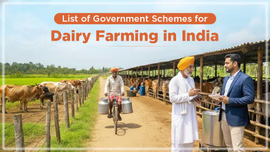PM Kisan Maandhan Yojana: Securing the Future of Small and Marginal Farmers

Table of Contents
- What is Pradhan Mantri Kisan Maan-Dhan Yojana?
- What are the Features and Benefits of Pradhan Mantri Kisan Maan-Dhan Yojana?
- What are the Eligibility Criteria?
- Who Should Not Apply for This Scheme?
- How to Apply for the Scheme?
What is Pradhan Mantri Kisan Maan-Dhan Yojana?
The Pradhan Mantri Kisan Maan-Dhan Yojana is one of the thoughtful initiatives taken by the government of India for small and marginal farmers. It is an old age pension scheme for the farmers holding a cultivable land of up to 2 hectares falling in the age group of 18 to 40 years. This voluntary and contributory scheme is effective from the 9th August 2019.
The objective of this scheme is to provide financial and social security to the small or marginal farmers through monthly pension. This is because they have minimal to no savings or any source of livelihood for their survival during their old age to support themselves. Under this scheme, on attaining the age of 60 years, the farmers are provided a minimum fixed pension of Rs. 3000 every month.
What are the Features and Benefits of Pradhan Mantri Kisan Maan-Dhan Yojana?
Let’s look at some of the salient features and benefits of the Pradhan Mantri Kisan Maan-Dhan Yojana:
- The fixed pension of Rs. 3000 will be paid to all the eligible farmers from a pension fund managed by the Life Insurance Corporation of India.
- In this voluntary and contribution based pension scheme farmers are required to contribute an amount according to their age which ranges between Rs. 55 to Rs. 200 in the pension fund till they reach the age of 60 years. Details are in table below.
|
Entry Age (Yrs) |
Member’s Monthly Contribution (Rs) |
Central Govt’s Monthly Contribution (Rs) |
|
18 to 22 |
55 to 68 |
55 to 68 |
|
23 to 28 |
72 to 95 |
72 to 95 |
|
29 to 34 |
100 to 140 |
100 to 140 |
|
35 to 40 |
150 to 200 |
150 to 200 |
- The central government will also make the same amount of contribution in the pension fund.
- The monthly contributions will be due on the same date for every month as enrollment date. The farmers have the flexibility to choose an option to pay their contributions on quarterly, 4-monthly or half-yearly basis. The contributions will fall due on the same date of the selected period as the enrollment date.
- Spouses of the eligible farmers are also allowed to join the scheme independently for a separate pension of Rs. 3000 per month when they reach the age of 60 years.
- The scheme provides the liberty of leaving the scheme anytime the farmer does not wish to continue for any reason. In this scenario, their contributions are returned to them along with the interest.
- In case the farmer dies before the retirement age, the spouse is allowed to make the remaining contributions in place of the deceased farmer. If the spouse does not wish to continue then they will receive the total contribution made by the farmer along with the interest. Also, if the deceased farmer doesn't have a spouse, then the total contribution with interest is paid to the nominee.
- In case the farmer dies after the retirement age, then the spouse is eligible for the 50% of the pension which is Rs.1500 every month as family pension.
What are the Eligibility Criteria?
The small and marginal farmers with a cultivable land of up to 2 hectares are eligible for this scheme. However, the farmers should fall in the age group 18 to 40 years and their names should appear in the land records of the States/UTs as on 01/08/2019. The farmer should possess an Aadhaar card and a savings bank account / PM-KISAN Account.
Who Should Not Apply for This Scheme?
- Farmers covered under any other social security schemes like National Pension Scheme (NPS), Employees’ Fund Organization Scheme etc. are not eligible.
- Farmers who are enrolled for Pradhan Mantri Shram Yogi Maandhan Yojana and Pradhan Mantri Vyapari Maandhan are not eligible for this scheme.
- The following categories of beneficiaries of higher economic status are also not eligible for the scheme:
- All Institutional Land holders, former and present holders of constitutional posts.
- Former and present Ministers/ State Ministers and former/present Members of Lok Sabha/ Rajya Sabha/ State Legislative Assemblies/ State Legislative Councils, former and present Mayors of Municipal Corporations, former and present Chairpersons of District Panchayats.
- All serving or retired officers and employees of Central/ State Government Ministries/ Offices/Departments and their field units, Central or State PSEs and Attached offices/ Autonomous Institutions under Government as well as regular employees of the Local Bodies (Excluding Multi-Tasking Staff / Class IV/Group D employees).
- All Persons who paid Income Tax in the last assessment year. (f) Professionals like Doctors, Engineers, Lawyers, Chartered Accountants, and Architects registered with Professional bodies and carried out their profession by undertaking practice.
How to Apply for the Scheme?
Once you have confirmed your eligibility, you can apply for the scheme through the common service centers in various states. Make sure to carry your Aadhaar card and savings bank account number with IFSC code. Additionally, carry your Bank Passbook / Cheque Book / Bank Statement for evidence of the bank account. You will be required to pay the enrollment fee of Rs.30 which will be borne by the government. Let’s peek into the mandate registration process step by step:
- Firstly, the initial contribution will be made to the Village Level Entrepreneur (VLE) in cash.
- The VLE will fill in your Name, Aadhaar number, and date of birth as mentioned on the Aadhar Card for authentication.
- Then the VLE will fill in the bank account details, mobile number, email address, spouse (if any) and nominee details for completing the online registration.
- System then auto calculates the amount of monthly contribution according to the age of the applicant.
- The applicant or subscriber will then be required to pay the 1st subscription amount in cash to the VLE.
- The Enrolment cum Auto Debit mandate form will be printed and then is required to be signed by the subscriber. VLE then scans the same and uploads it into the system.
- Once the entire process is completed, a unique Kisan Pension Account Number (KPAN) is generated and the Kisan Card is printed.
This significant, affordable, and structured initiative taken by the government not only eradicates the economic vulnerabilities of the small farmers but also empowers them as they age.


Related Blogs












